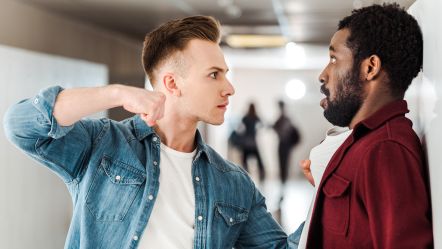Masculinities
Gender is present in every aspect of our lives and affects everyone without exception. This includes men. Gender-based violence is rooted in, and reinforces, gender-based inequalities and cannot be understood outside social structures, gender norms and supporting or reinforcing roles

Masculinities are those behaviours, languages and practices, existing in specific cultural and organisational locations, which are commonly associated with men, thus culturally defined as not feminine64.
There is no universal set of expectations around masculinity: within societies, there are dominant codes that exert pressure on, and create expectations around men - with consequences for women, children and society as a whole. The understanding of masculinity varies across time and socio-cultural contexts, and within groups and networks; and men also 'perform' their masculinity differently and inconsistently. Just as masculinity is defined by its relationship with femininity, women too have an important role to play in the interpretation and understanding of masculinity, particularly in their interaction with men and boys.

Masculine identities
Masculine identities are constructed through difference and association: being a man involves both not being something other than a man, and being like certain other men. Masculinity involves displaying attitudes and behaviours that signify and validate maleness, and involves being recognised in particular ways by other men and women.
R.W Connell, in her book Masculinities (1995), argues that what is important to a meaningful analysis of gender and masculinity is the “…processes and relationships through which men and women conduct gendered lives. ‘Masculinity’, to the extent the term can be briefly defined at all, is simultaneously a place in gender relations, the practices through which men and women engage that place in gender, and the effects of these practices in bodily experience, personality and culture”65.
Connell argues that it is important to consider the power relationships between different masculinities as well as their relationships with femininities in order to analyse how these relationships act to reproduce, support or challenge the distribution of power in society. She identifies five categories of masculinities, which have been criticised, and should be regarded as fluid rather than rigid:
Hegemonic masculinities are masculinities that are highly visible, respected, and occupy a position of authority in relation to other masculinities, within a particular setting. Such masculinities may not be the most widespread form, but they are likely to be those most admired, and they represent standards for others. Examples might include decisive business leaders, popular boys in a peer group, and certain sportsmen. Hegemonic masculinities can be seen as dominant in the entire gender order. A successful claim to authority is the mark of hegemony, rather than acts of direct violence, although violence underpins and supports this authority. Hegemony is supported by the production of exemplars - symbols with recognised authority - even though most men cannot live up to the ideal.
Complicit masculinities
To be complicit means to condone or support something, without being actively engaged in it. Complicit masculinities are those that benefit in general from the social dominance of men, while not actively seeking to oppress women. A complicit action would be to deny the existence of inequality or other problems, or merely not to question the way in which gender relations are generally ordered.
Subordinate masculinities
Within the overall framework, there are gender relations of dominance and subordination between groups of men. The most common example is the dominance of heterosexual men and the subordination of homosexual men. From the point of view of hegemonic masculinities, homosexuality is easily assimilated to femininity, and is therefore seen to be inferior. Other examples include men who have made a conscious effort to contest and ‘exit’ from hegemonic and complicit positions, or those whose physical appearance does not conform to standards set by hegemonic exemplars.
Marginalised masculinities
Marginalised masculinities are those that are categorised as different, on the basis of class, ethnicity or status. They may display and enjoy masculine power in certain contexts but are always ultimately compared to the hegemonic norms and images66.
Protest masculinities
Protest masculinities represent a pattern of masculinity constructed in local working-class settings, sometimes among ethnically marginalised men, which embody the same claims to power of typical hegemonic masculinities, but which lack the economic resources and institutional authority which underpin regional and global patterns67

The crisis of masculinity and men’s rights movements
Ever since the early 1990s, men and masculinities have been an issue of concern in relation to unemployment, changing family patterns, school failure, and violent crime. Some researchers argue that young men feel disoriented, and experience conflicting societal demands, which make it difficult to build their (gender) identities as young men. On the one hand, traditional expectations of masculinity demand toughness, strength and rationality, while on the other hand, ‘modern men’ are expected to possess soft skills, such as empathy and sensitivity. These seemingly conflicting requests can have a negative impact on the development and behaviour of boys and young men, leading to aggression, low self-esteem and drug abuse. In their study of young masculinities and femininities, Nayak and Kehily claim that “Identity only becomes an issue when it is in crisis, when something assumed to be fixed, coherent and stable is displaced by the experience of doubt and insecurity”68.
‘The work of Ken Harland with young men and boys in Northern Ireland has shown that young men experience ambivalence about their ‘public’ and ‘private’ personas.
In public, there is great pressure to appear confident, and to display their masculinity in a forceful way; and there is a fear of being humiliated as a result of appearing weak or feminine. In ‘private’, young men face their anxieties, and try to address their fears and inner emotions, but they tend to have little support and few available mechanisms at their disposal to help them to become more skilled at expressing their emotions and reflecting on their identity and behaviour. For most young males, their daily experience tends to contradict societal perceptions of masculinity: they often feel powerless, fear the threat of daily violence, may be labelled ‘stupid’ at school, pay little attention to their health needs - particularly mental health - have not been in a sexual relationship or have little sexual experience, and feel that adults see them as ‘immature.’ Such conflicting experiences need appreciating in order to understand the internal pressures that many young males experience in constructing their masculine identity and in knowing what it means to be a man.
In the first half of the XX century, men’s rights movements have increasingly begun to emerge as a way of opposing the claims of women’s movements for emancipation and equal rights. From the men’s liberation movement in the 1970s, two main branches evolved: pro-feminist men’s movements and antifeminist men’s movements. The second of these are mostly branded as ”men’s rights movements”. Some of the men’s rights movements claim that men are in fact the oppressed and discriminated, arguing that men and society have been ‘feminised’ by the success of the women’s movement. Most of the men’s rights movements oppose feminism and argue for the maintenance or reestablishment of a patriarchal gender order. The emergence of the Internet has allowed such movements to reach wider audiences. Men’s rights groups and father’s rights groups are generally associated with a shift towards a more conservative approach to the family and gender relations, and such movements have become increasingly vocal in Europe. However, research also shows that in certain countries, policies encouraging men to take a more active fathering role have facilitated women’s entry into the labour market. There are also indications of an increasing interest in feminist ideas even while men’s rights movements have gained in popularity.69

Risk taking behaviours and young men
Young men often willingly jeopardise their health by engaging in high-risk activities, as a result of clinging to stereotypical images of men and masculinity.
The notion of risk is a recurring theme in young men’s health statistics. This can be seen by observing male risk-taking behaviours, such as driving without a seat belt, eating snack foods, fighting, street violence, not visiting doctors, alcohol abuse, car theft, and increased suicide rates. While the young men may have been aware of the dangers, they perceived risk-taking as a necessary aspect of male youth culture, and as an important way in which males demonstrate their masculinity to others.70
Research shows that violence plays an integral and complex role in male identity, and that it is an accepted and normal part of many boys’ lives and experiences. Young men tend to refer to violence primarily in relation to men’s violence towards other men. Violence has been seen as a way to assert one’s masculinity in front of other men, or a way of dealing with things that might challenge aspects of masculinity and cause a feeling of shame.71
Violence fulfils a function in relation to stereotypical gender roles. Violence, as an integral and complex aspect of male identity also ‘serves to maintain group solidarity, reinforce kinship ties, affirm allegiances and enhance status within the group’72. For other young men, the function is related to self-protection, where an attempt to use violence or aggression or threat is seen as a means of warding off a threat from another.
While it is certainly the case that gender-based violence affects women disproportionately, and while men are the main aggressors, they too experience violent consequences as a result of the assumptions and beliefs which underlie gender-based violence. Perhaps nothing shows this better than the history of conflict and genocide.
Gender and genocide studies have long focused on the under-reported stories of women, especially stories about rape and abuse within conflict, which have tended to be excluded from early accounts of the Holocaust and genocide up to the 1980s. A closer look shows that men too are gendered in genocidal processes.
They are often the first group to be separated and massacred, allowing for the killing and exploitation of women and children. For example, on 12 July 1995, more than 8000 Bosnian Muslim men and boys were murdered in and around the town of Srebrenica by Bosnian Serb forces73. Adam Jones identified two types of genocides:
- gender selective slaughter of males, and
- “root-and-branch” genocides which target all sectors of the target population indiscriminately.
Genocides targeting battle-age males are more frequent than the second type, portraying a brutal logic and understanding of masculinity: males are those who can serve in the military, and are therefore legitimate targets. However, this does not imply that women are saved from the worst types of genocidal violence. While the violence that they are exposed to is often less deadly, it is no less shocking: it may involve verbal humiliation, sexual slavery, individual and gang rape, or rapemurder on a large scale.74
64 Whitehead, S.M., Barret, F.J., The Masculinities Reader, Polity Press, 2004
65 R.W. Connell, Masculinities, 2nd edition, University of California Press, Berkeley, 2005
67 R.W. Connell, James Messerschmidt, Rethinking hegemonic masculinities, in GENDER & SOCIETY, Vol. 19 No. 6, December 2005, p. 829-859.
68 Nayak, Anoop; Kehily, Mary Jane, Gender, Youth and Culture: Young Masculinities and Femininities, 2nd edition, Palgrave Macmillan, Kindle Edition, 2013, p. 56
69 Sandy Ruxton, Nikki van der Gaag, Men’s involvement in gender equality – European perspectives, Gender and Development, 21:1, 2013, p. 161-175.
70 Ken Harland, Young Men Talking – Voices from Belfast (1997) YouthAction Northern Ireland and Working with Men Publications, London
71 Ken Harland, Sam McCready, Boys, young men and violence : masculinities, education and practice, Palgrave Macmillan, 2015, p. 134
73 The International Criminal Tribunal for the Crimes in the Former Yugoslavia ruled in 2004 that the crime constituted genocide. The ruling was upheld in 2007 by the International Court of Justice.
74 Adam Jones, Genocide. A Comprehensive Introduction, Routledge, 2006, p.328-329.
Youth work and masculinities
Any youth work addressing gender-based violence needs to address the concepts and constructions of masculinity and femininity that young people are exposed to, and needs to support them to reflect critically on these concepts and on their own relationship to, and performance of gender.
Traditionally, work against discrimination has focused on the empowerment of girls and women, and this needs to remain an important focus.
However, working with boys and young men is also needed, partly in order to support them in exploring their identity and reflecting on their understanding of masculinity and on the social pressures surrounding this concept ; but also in order to encourage them to engage actively against gender-based violence and for gender equality.


